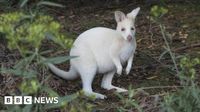Jag Alli was just finishing a routine school run on the morning of September 12, 2025, when he encountered something that made him slam on the brakes—quite literally. Driving along Green Street Green Road near the junction with Gore Road in Dartford, the All Night Cars taxi driver noticed traffic slowing for no apparent reason. As he edged forward, he found himself face-to-face with an animal he never expected to see on a Kent roadside: a white—or more precisely, albino—wallaby.
“I was just doing the kid run and was wondering why traffic started to slow for no reason,” Jag told UK News in Pictures. “Then it was my turn at the front, and no one stopped to let it go.” At first glance, he thought it was a white kangaroo, but authorities later confirmed it was an albino wallaby. “These aren’t the kind of animals you can buy. It looked like he was blind in one of his eyes, that’s why I didn’t grab him,” Jag added, still sounding a bit incredulous about the morning’s events.
As traffic backed up behind him, Jag quickly realized he had to act. “I had to stop my car and hold up the traffic because the kangaroo was trying to cross the road,” he told KentOnline. “I was shocked. My passenger took pictures, but I said: ‘This isn’t cool, this is big, this is not normal’. You don’t just see a kangaroo at the side of the road.”
Jag considered putting the animal in his car boot and taking it to authorities or somewhere safe, but a combination of concern for the animal’s health—he suspected it might be blind in one eye—and a healthy respect for wallabies’ powerful legs made him think twice. “I stayed away because I was afraid of the punches and kicking, or putting me in a headlock,” he said, referencing viral videos of marsupials defending themselves.
Instead, Jag attempted to guide the wallaby back toward the greenery. “At first, I tried to take a closer look, but he ran away from me,” he explained. “A lorry approached, and I got to the other end – I had no choice but to persuade him to go back to where he came from.” Eventually, the wallaby found a quiet corner and disappeared into the underbrush. “I’m usually brave with animals – I would have even put him in the boot to get him somewhere safe,” Jag noted, half-jokingly.
It didn’t take long for the incident to make waves online. Jag filmed part of the encounter and shared it on social media, where the video quickly racked up nearly 70,000 views. “Nowadays, you put it on Facebook and people come forward. Hopefully, the right people will know who owns him,” Jag remarked, hoping the footage would help reunite the animal with its rightful owner.
As it turns out, Jag’s hopes were realized faster than anyone expected. At approximately 9:30 a.m., Kent Police received a call reporting a white wallaby on Trolling Down Hill, not far from where Jag had seen the animal. Officers arrived promptly to ensure the safety of both road users and the wallaby. “Officers attended to ensure the safety of road users and of the animal,” a police spokesperson told BBC News. “Enquiries were completed and the wallaby was safely reunited with its owner shortly after 10am.”
Jag was delighted to hear the outcome. “I thought he was from a zoo, someone’s pet or just living in the bush. My brain was going at 550mph trying to digest what was going on,” he said, reflecting on the surreal experience. The authorities later confirmed that the wallaby was indeed an owned animal and not a wild escapee.
While the sight of a wallaby on a British road is rare enough to cause a traffic jam and a flurry of social media posts, it’s not entirely unprecedented. Wallabies, members of the macropod family alongside kangaroos, are native to Australia and nearby islands. They’re typically small to medium-sized, with powerful hind legs built for bounding at high speeds and jumping impressive distances. According to a 2020 research paper by Holly M. English of University College Dublin and Anthony Caravaggi of the University of South Wales, wallabies were likely first brought to the UK for zoos and private collections in the late 19th century. During the World Wars, some were released into the countryside as their owners could no longer care for them.
Helen Pearson, head of animal studies at Suffolk Rural, explained to the BBC that wallabies can survive “quite well” in the UK. “They live in shrubland out there, so as much as you think Australia is quite hot, they cope quite well in our climate,” she said. “They’re really hardy animals.”
The RSPCA has previously noted that most people are “unaware” wallabies—capable of jumping up to six feet high—are considered established in the wild in Britain. Escapes from captivity have led to small populations living in the wild, though most wallabies seen in urban areas are pets or zoo animals that have gotten loose. Earlier in 2025, another albino wallaby escaped twice in one week in Kent, suffering injuries before the RSPCA managed to rescue it. That animal was first spotted near Broomfield Bank water works on Folkestone Road, following a string of social media alerts, and was eventually found cowering in some bushes in Elms Vale Road at Hougham, near Dover.
Incidents like these highlight the growing presence of exotic pets in the UK and the challenges that come with them. While the novelty of seeing a wallaby in Dartford is undeniable, there are concerns about animal welfare and public safety. The RSPCA and local authorities urge pet owners to ensure their animals are securely housed and to report any escapes immediately.
For Jag Alli, the encounter will be one to remember. “I was on the way back to the office and now I was faced with a kangaroo in Dartford,” he said, still a bit amazed. His quick thinking and willingness to help likely prevented harm to the animal and a potential accident on a busy road.
As for the white wallaby, it’s back home, safe and sound—at least for now. But with the rise in exotic pets and the occasional escape, Kent residents may want to keep their eyes peeled. Who knows what might bound across the road next?




